Final Fantasy 7 Rebirth is now out, though just like our best tips guide, there are some things you may want to adjust before playing. Luckily, we’ve prepared this guide with what we feel are the best settings to play Final Fantasy 7 Rebirth with, including whether you should go with visuals or performance mode.
Final Fantasy 7 Rebirth Best Settings:
We’ve included a list of options that should be changed before you start the game. Things not listed mean they should stay on default, though you should still look at them if you want to change something, like camera invert, language, etc.
Graphics
- Optimization – Performance – You lose image quality, with the background slightly blurrier versus the graphic mode, but the 60 FPS increase (over 30 FPS) is a vastly superior experience. With how much you’ll be moving around, you’ll likely not notice the image quality drop either. Overall, the gains in performance far outweigh the loss in image quality. Unless down the road Final Fantasy 7 Rebirth gets a VRR uncapped quality mode update, I highly recommend sticking with performance mode.
Gameplay
- Difficulty – This is all user preference, but I will say that Final Fantasy Rebirth can be pretty challenging, even on the easiest difficulty. I suggest starting out on either easy or normal and working your way up to dynamic, which easily adjusts their difficulty to your skill level.
- Combat Style
- Active (Recommended) – If you plan on doing a hard mode run, I suggest playing the game with the Active combat style. That means you’ll have full control over characters, and they won’t perform any auto actions, which you’ll need to be used to in hard mode.
- Classic – If you want a super easy time, use this as characters will auto-move and dodge, leaving you to focus on executing commands. This feature is not available in hard mode.
- Subtitles – I had this set to dialogue and speaker name, but you can turn it off for a cleaner UI.
- Chat Log – This is a log of characters speaking in the world. I found it distracting, so I turned it off. Plus, the UI is cleaner with it off.
- Trigger Effect Function – The triggers don’t get used much, so I do suggest having them on unless you are playing a mini-game that involves shooting. Turn it off then, as no resistance will help you shoot faster.
Camera
- Camera Distance: Out of Battle – 3 – I set this to the max; I like having more viewing space, letting me see some things that would otherwise be offscreen.
- Camera Distance: In Battle 3 – Same deal as the previous option.
- Responsiveness – 4-5 – This isn’t some first-person shooter, so maxing out the responsiveness isn’t going to be insanely hard to keep up with. The default setting felt pretty slow, though, and being in battle, having a faster camera does help.
- Screen Shake – Off
Audio and Vibration
- Transmission Dialogue Playback Device – Standard Speaker – Unless you like playing audio through your controller, I suggest immediately changing this to your speaker.
The next bit is only unlockable when you beat the game the first time. We’ll keep the spoiler part out of the settings.
Extra Settings (Requires you to beat the game once)
- Tactical Mode Slowdown – 6 – This will help during hard mode, slows combat down more when the tactical menu is open.
- Materials Auto-Collection – On – Why this isn’t part of the based settings is beyond me, but turn this on right away to auto-pick up stuff.
Not much else in terms of settings here, as most of the defaults are good to have. Sadly, there is nothing to completely remove the HUD while exploring or making it vanish in special cutscenes during combat, though hopefully that gets patched. Otherwise, these are basically the big options I recommend changing or playing around with.
If you’re not sure whether you want to pick up Final Fantasy7 Rebirth, go read our review here where we mention how it’s in the running for Game of the Year.
